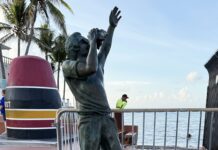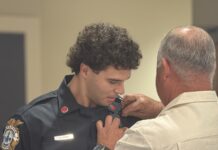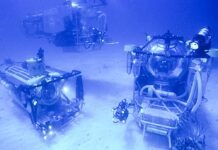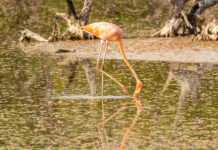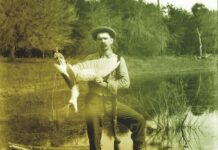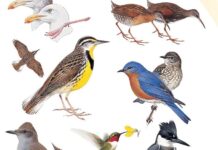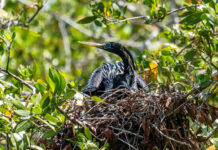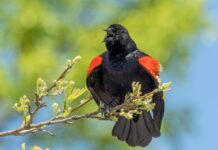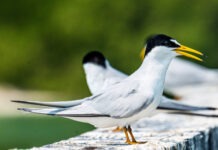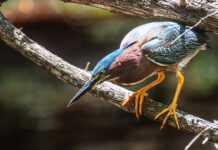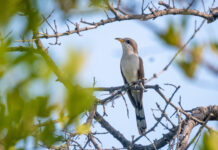Fort Zach was packed, flip-flops and burnt shoulders everywhere, even on a chilly day, by Keys standards. I start-stopped my way carefully through the first two parking lots, never even touching the accelerator, pulling to a muddy spot in the third lot only a couple of spaces from the ocean. The big storm had just passed through the night before, and the water was that ’80s turquoise T-shirt color it gets when it’s all churned up on a bright, sunny day. The wind was still heavy out of the north and two shrimp boats anchored half a mile out were the only boats to be seen.
I’d had a premonition that morning, of the moat outside the fort filled by weird ducks who’d ridden out the storm on its calmer waters. When I ambled around all the puddles in the parking lot and down the incline to the low fringe of mangroves at the edge of the moat, my long streak of having absolutely no extrasensory perception continued unabated. There were no weird ducks in the pond. There were no ducks at all.
I kept walking along the edge of the moat, though, heading where all the people weren’t, as ducks will occasionally swim out from under the mangroves when you do that.
There were two other birds at the Navy end of the moat – a great egret biding her time, and an anhinga with his wings held out, doing a little thermoregulating.
With so little avifauna around, I started to pay attention to the butterflies, taking a lot of pictures, but not knowing what species they were, especially the big yellow ones that looked like flying pats of butter.
I was down at the far end of the Back 40, near what everyone calls the secret beach, when I ran into Ellen Westbrook, all bundled up, walking her dog Che. I hadn’t seen her for a few weeks, so we walked and talked for a while, keeping an eye out for birds. Ellen was telling me how much she loved the production of “Singing in the Rain” at the Waterfront, when we spotted them – swallow-tailed kites.
At first there were two, then three, then five, all of them low, swinging around over the tree tops at the far end of the fort. You couldn’t really get any field marks at that distance, but you could just tell by the way they flew.
Seeing a swallow-tailed kite is nothing new in the Keys. Last year 3,025 were counted by the folks at the Florida Keys Hawkwatch. But those were seen in the late summer and early fall, southbound migrants. (Swallow-tailed kites migrate a month or two earlier than other migratory species.)
The number we see in the fall is thought to be the result of geography. The North American population of swallow-tailed kites breeds in Florida and a few other nearby states. The entire population winters in South America. Most raptors that migrate through Florida follow the peninsula down as far as they can, then follow the Keys until Marathon or below before crossing over to Cuba and points south. And as Florida Keys Hawkwatch has shown, a good number of swallow-tailed kites do the same. But satellite tracking by the folks at the Avian Research and Conservation Institute has shown that many swallow-tails will leave the Florida peninsula from seemingly random places on the west coast. This is due to the fact that they are some of the best, most energy-efficient flyers out there, and the water crossings most raptors either avoid – or go to great distances to minimize – don’t seem to phase swallow-tailed kites.
That being said, when they return to North America, their routes are even less focused. So seeing them come in off the water, the day after a major storm, is, well, something.
Seeing them fly in general is always something in itself.
No birder – really, no person who gets a good look at them – is immune to their charm. Hard-hearted ornithologists tend to throw out terms like “handsome,” “striking,” “graceful,” “extremely graceful,” and “extraordinarily graceful” to describe them. I’ve probably waxed too much in this column before about what amazing and subtly deft flyers they are, but I don’t take any of it back. It feels kind of necessary. The birds just loop through the air with the greatest of ease, with a lightness that puts the best acrobats of the hominid variety to shame.
A bird named after part of another bird’s anatomy could seem like kind of an oddity, but eight other bird species have the descriptor “swallow-tailed” in their name, among them a cotinga, a hummingbird and a bee-eater. All have tails that look a bit like the forked V-shape of a barn swallow’s, but, after surveying photos of the other swallow-tails, the swallow-tailed kite, in my humble opinion, is the barn swallow-iest. (Fun fact: kites are not named after the manmade things that hang on a string in the breeze. The things on strings are named for the birds)
The mechanics of their grace, if grace can be reduced to mechanics, comes down to that tail. Swallow-tailed kites rarely flap. Instead they hold their wings out steady and stable, tail fanned wide, in constant motion, sometimes sliding all the way from horizontal to vertical to horizontal again in half a second.
They tend to fly in sliding horizontal loops through the air, pausing for the briefest of moments when they face into the wind, then starting another loop. I’ve often felt that if you trace the lines they unravel across the sky, they’d reveal some kind of code for better living.
At first, Ellen and I started to make our way closer to them, hoping for a better look. But it became clear rather quickly that we wouldn’t get there in time. They weren’t pausing because they’d made it to land. They just kept moving.
We watched them for two minutes, tops, before they disappeared over the trees, working their way across Key West, toward the rest of the Keys, the mainland, and back to their breeding territories to start their annual cycle all over again.

